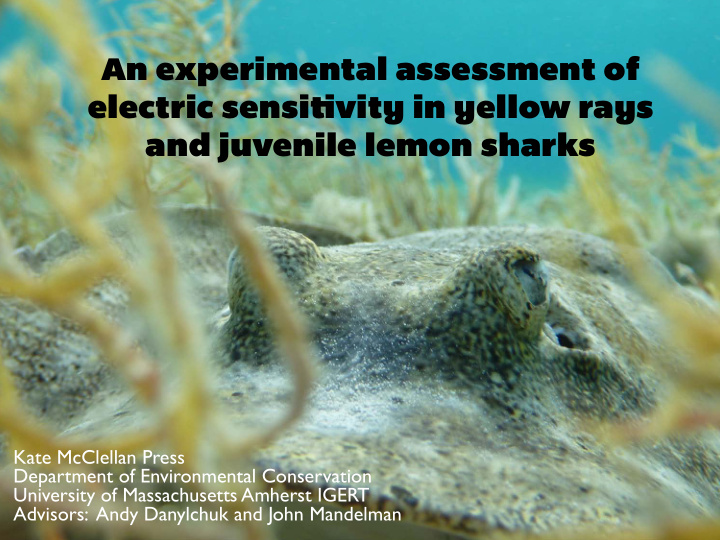



An experimental assessment of electric sensi tj vity in yellow rays and juvenile lemon sharks Kate McClellan Press Department of Environmental Conservation University of Massachusetts Amherst IGERT Advisors: Andy Danylchuk and John Mandelman
Acknowledgements Owen O’Shea Ian Bouyucous Edd Brooks Mike Cortina Andy Danylchuck CEI Shark Interns John Mandelman Island School Students
How do new ocean uses a ff ect marine life? Photo: ¡Siemens ¡Press ¡
Why are we interested in elasmobranchs? Photo: ¡C ¡J ¡Crookes ¡
How do we know where our food is? Photo: ¡sciam.com ¡
¡ Ampullae of Lorenzini
Image: ¡hvpd.co.uk ¡
Shark bites cable
¡ Lemon shark, Negaprion brevirostris Yellow ray Uroba tj s jamaicensis Photos: ¡Federico ¡Cabello ¡and ¡Andy ¡Murch ¡ ¡
QUESTIONS • What ¡are ¡the ¡sensory ¡ranges ¡of ¡lemon ¡ sharks ¡and ¡yellow ¡rays? ¡ • How ¡do ¡arEficial ¡electric ¡fields ¡affect ¡the ¡ behavior ¡of ¡lemon ¡sharks ¡and ¡yellow ¡rays? ¡ • What ¡is ¡the ¡transiEon ¡threshold ¡from ¡ aHracEon ¡to ¡repulsion ¡of ¡the ¡two ¡species? ¡ • Are ¡variaEons ¡in ¡individual ¡behaviors ¡ within ¡species ¡due ¡to ¡morphology? ¡ ¡
Cape Eleuthera Ins tj tute, Eleuthera, The Bahamas
¡ ¡ ¡ ¡ ¡ ¡ ¡ Cape Eleuthera Institute Lemon shark capture sites Yellow ray capture sites
Photo ¡Credit: ¡Owen ¡O’Shea ¡
Photo ¡Credit: ¡Peter ¡Aronson ¡
Morphometrics FL ¡ TL ¡
¡ < ¡2 ¡μA ¡ 9 ¡μA ¡ Olfactory Source 20 ¡μA ¡ 90 ¡μA ¡ 250 ¡μA ¡ Inactive 1500 ¡μA ¡ Dipole ¡ Active Power source Dipole Multimeter Variable resistors
Future Research
QUESTIONS?
Recommend
More recommend